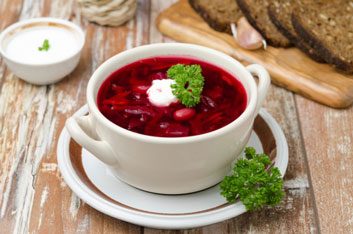
1. Borscht
There’s no single recipe for borscht – it can be made with or without different meats and can include any type of vegetable, primarily root veggies – but the main ingredient is always beets. “Beets are highly nutritious,” says Shannon Crocker, a registered dietitian and nutrition consultant. “They contain an antioxidant called betaine that helps fight inflammation and boosts liver health.” Not only that, but beets are low in calories and high in fibre, potassium (which is important for healthy blood pressure) and folate.
To lighten up a family recipe that probably includes a dollop of sour cream on top, try swapping in tangy Greek yogurt instead.
Another way to eat beets: Bulgur, Orange and Beet Salad
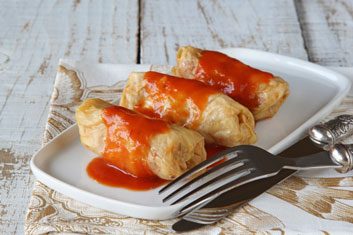
2. Cabbage rolls
Since cabbage grows well in colder climates, it’s no surprise it’s a staple in Russian diets. A cruciferous vegetable, Crocker says cabbage is an excellent source of vitamin C, contains lots of antioxidants and is “packed with phytochemicals that help reduce risk for cancer and have anti-inflammatory effects.”
But be warned: although cabbage keeps for a long time, it does start to lose nutritional value over time, so don’t keep it forever! Similarly, don’t cook your cabbage to mush if you want to maintain nutritional value. Try cabbage roll recipes with shorter cooking times to retain disease-fighting nutrients.
Lighten up cabbage rolls by choosing lean ground beef or ground turkey, or even skipping the meat altogether in favour of a whole grain.
Bonus: cabbage rolls are often served with a tomato-based sauce on top. “Cooked tomato products are high in lycopene, an antioxidant associated with reduced risk for certain cancers,” says Crocker.
Also try: Cabbage and Carrot Soup
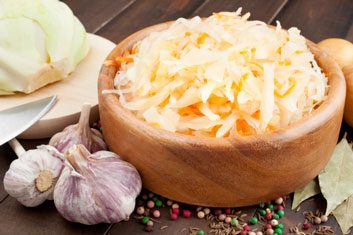
3. Sauerkraut
More cabbage! Many Eastern European countries love sauerkraut as a side dish. It’s easy to make, cabbage is readily available and it’s healthy. Not only do we get the nutrients from cabbage itself, but according to Crocker, fermented foods are believed to have a variety of health benefits, including improved gut (GI) health resulting in decreased lactose intolerance, irritable bowel and inflammation.
Eating fermented foods like sauerkraut or yogurt might also boost the health of the good bacteria in your stomach, which not only improves gut health but also helps boost nutrient absorption.
Finally, fermented foods paired with a healthy diet and active lifestyle may play a role in helping reduce your risk of colon cancer.
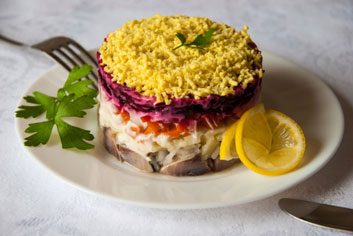
4. Dressed herring
“Herring under a fur coat” is a traditional salad in Russia. It’s composed of layers of finely chopped pickled herring, eggs, beets, carrots, potatoes and usually a mayonnaise- or sour cream-based dressing. It’s not necessarily North America’s idea of a delicious salad, but we can’t deny that many of the individual ingredients are healthy.
“Herring, along with other fatty fish like salmon and mackerel, is a good source of protein and heart-healthy omega-3 fats,” says Crocker. Because they’re small fish, they’re also lower in contaminant levels (like mercury) than larger fish such as tuna. Similarly, you can’t go wrong with the root veggies usually found in this salad – potatoes, carrots and beet – and the protein-filled eggs.
But be cautious – the layers of mayonnaise are nothing but excess fat and salted herring is high in sodium.
Crocker’s suggestions for a healthier version:
– try steaming and grating instead of long boiling to retain more of the veggies’ nutrients
– use lower fat mayonnaise and spread or layer it lightly
– try lower fat (e.g. 2%) plain Greek yogurt in place of the mayonnaise for a lower fat option that also has more protein and calcium
– consider mixing part mayo, part Greek yogurt
– look for a recipe with fresh, grated apple to boost fibre
Or, another healthy option to try: Tomato-Roasted Mackerel
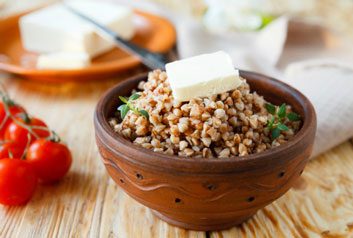
5. Kasha
Apparently, there is an old proverb that says “You can’t feed a Russian without a kasha.” These porridges are usually made with whole grains like buckwheat and millet.
“These pack a powerful punch when it comes to nutrition,” says Crocker. “Whole grains are filled with B vitamins and rich nutrients including potassium, iron and fibre,” which means just a small amount of kasha should fill you up.
“Research shows that healthy diets rich in whole grains, instead of refined grains, can help to boost heart health and reduce risk for colon cancers,” says Crocker. To make the most of your kashas, make them with milk, rather than cream, and complement them with veggie sides instead of fatty meats.
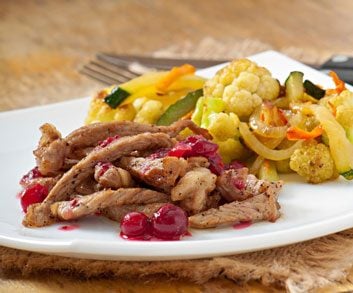
6. Beef Stroganoff
Possibly one of the better-known Russian dishes, Beef Stroganoff is both a wonderful comfort food and a healthy choice – if you make it right.
According to Crocker, the beef gives us a high quality protein boost and is an excellent source of zinc and the type of iron our bodies absorb easily and use (both of which we need to help keep our immune systems up to snuff, particularly during cold and flu season). Beef is also packed with B vitamins.
The mushrooms in beef stroganoff are low in calories, filled with fibre and contain B vitamins important for our metabolism, as well as minerals such as selenium, which is good for a healthy immune system. The fibre, combined with the protein, make this meal a “long-lasting energy dish,” says Crocker.
Crocker’s tips for making a healthy beef stroganoff:
– use lean stewing beef and simmer low and slow to make it tender
– increase the measurement of mushrooms for low-calorie fillers
– use low-fat sour cream or Greek yogurt
– swap regular broth for a sodium-free version; make up for the flavour loss by adding more garlic and a splash of red wine instead
– serve a small portion of stroganoff over whole wheat egg noodles or a whole grain like brown rice or a kasha and enjoy with a side of leafy greens for a complete meal
Your healthy version: Beef Stroganoff
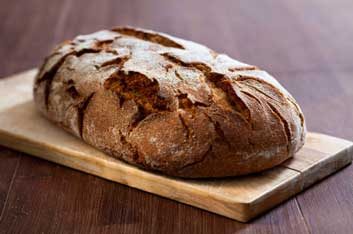
7. Rye bread
Love rye bread? So do Russians, for all types of sandwiches and to accompany their wide variety of soups. Some types are healthier than others, though: some dark rye bread is made with white flour and is darkened with molasses, dark corn syrup or even food colouring, says Crocker.
Check the ingredients list to be sure what you’re getting. “If the first ingredient is ‘enriched flour’ or ‘unbleached wheat flour,’ those are both just white flour. If it’s made with ‘rye flour,’ it could still be refined – and that’s not much different than white bread,” says Crocker. Look for “whole rye,” “whole grain rye” or “whole grain pumpernickel” for authentic (and healthy) rye bread.
Traditional rye breads are made with a sour dough starter, which Crocker says is actually healthier. They have a lower glycemic level, so they won’t spike your blood sugar like white bread.
Try: Light Rye Bread
Related:
• Sochi 2014: Canadians to watch
• Sochi 2014: New Olympic events
• 10 of the most nutritious foods in the world
